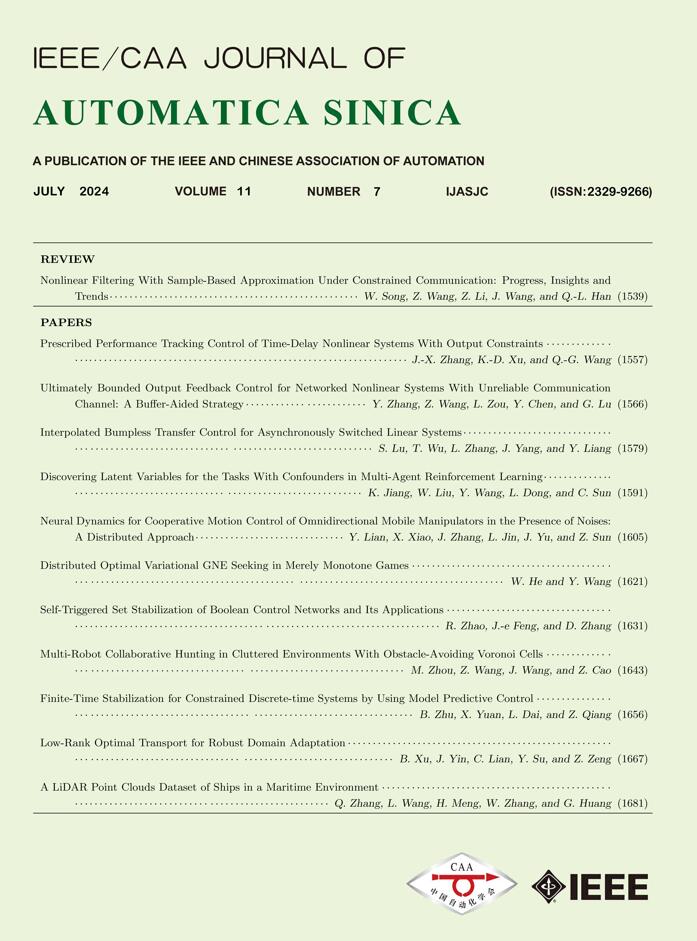 Volume 11
Issue 7
Volume 11
Issue 7
IEEE/CAA Journal of Automatica Sinica
| Citation: | S. Gao, Z. Peng, H. Wang, L. Liu, and D. Wang, “Long duration coverage control of multiple robotic surface vehicles under battery energy constraints,” IEEE/CAA J. Autom. Sinica, vol. 11, no. 7, pp. 1695–1698, Jul. 2024. doi: 10.1109/JAS.2023.123438 |

| [1] |
H. Li, M. Zhou, K. Hao, and E. Hou, “A survey of multi-robot regular and adversarial patrolling,” IEEE/CAA J. Autom. Sinica, vol. 6, no. 4, pp. 894–903, 2019. doi: 10.1109/JAS.2019.1911537
|
| [2] |
C. Jie, S. Jian, and G. Wang, “From unmanned systems to autonomous intelligent systems,” Engineering, vol. 12, no. 5, pp. 16–19, 2022.
|
| [3] |
T. Li, R. Zhao, C. Chen, L. Fang, and C. Liu, “Finite-time formation control of under-actuated ships using nonlinear sliding mode control,” IEEE Trans. Cybern., vol. 48, no. 11, pp. 3243–3253, 2018. doi: 10.1109/TCYB.2018.2794968
|
| [4] |
L. Ma, Y.-L. Wang, and Q.-L. Han, “Cooperative target tracking of multiple autonomous surface vehicles under switching interaction topologies,” IEEE/CAA J. Autom. Sinica, vol. 10, no. 3, pp. 673–684, 2023. doi: 10.1109/JAS.2022.105509
|
| [5] |
N. Gu, D. Wang, Z. Peng, and J. Wang, “Safety-critical containment maneuvering of underactuated autonomous surface vehicles based on neurodynamic optimization with control barrier functions,” IEEE Trans. Neural Netw. Learn. Syst., vol. 34, no. 6, pp. 2882–2895, 2023. doi: 10.1109/TNNLS.2021.3110014
|
| [6] |
A. Kwok and S. Martinez, “Unicycle coverage control via hybrid modeling,” IEEE Trans. Automat. Contr., vol. 55, no. 2, pp. 528–532, 2010. doi: 10.1109/TAC.2009.2037473
|
| [7] |
J. Li, Y. Xiong, J. She, and M. Wu, “A path planning method for sweep coverage with multiple UAVs,” IEEE Internet. Things J., vol. 7, no. 9, pp. 8967–8978, 2020. doi: 10.1109/JIOT.2020.2999083
|
| [8] |
L. Zuo, W. Yan, R. Cui, and J. Gao, “A coverage algorithm for multiple autonomous surface vehicles in flowing environments,” Int. J. Control, vol. 14, no. 2, pp. 528–532, 2016.
|
| [9] |
C. Song, L. Liu, G. Feng, Y. Fan, and S. Xu, “Coverage control for heterogeneous mobile sensor networks with bounded position measurement errors,” Automatica, vol. 120, p. 109118, 2016.
|
| [10] |
J. Hou, X. Zeng, G. Wang, J. Sun, and J. Chen, “Distributed momentum-based frank-wolfe algorithm for stochastic optimization,” IEEE/CAA J. Autom. Sinica, vol. 10, no. 3, pp. 685–699, 2023. doi: 10.1109/JAS.2022.105923
|
| [11] |
Z. Pang, W. Luo, G.-P. Liu, and Q.-L. Han, “Observer-based incremental predictive control of networked multi-agent systems with random delays and packet dropouts,” IEEE Trans. Circuits-II, vol. 68, no. 1, pp. 426–430, 2021.
|
| [12] |
C. Zheng, Z. Pang, J. Wang, J. Sun, G.-P. Liu, and Q.-L. Han, “Null-space-based time-varying formation control of uncertain nonlinear second-order multi-agent systems with collision avoidance,” IEEE Trans. Ind. Electron., vol. 70, no. 10, pp. 10476–10485, 2023. doi: 10.1109/TIE.2022.3217585,2022
|